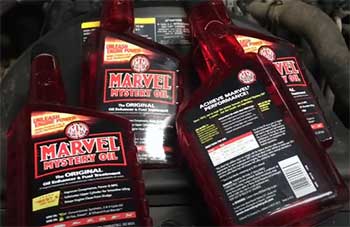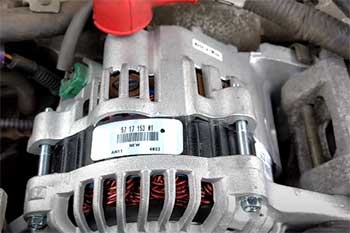I’ve always been drawn to Porsche’s ability to blend heart-pounding performance with everyday usability, but choosing between the 2024 Porsche Panamera Turbo E-Hybrid and the iconic Porsche 911 feels like picking a favorite song—they’re both incredible, yet they hit different notes.
In this article, I’ll take you through my experience analyzing these two masterpieces, comparing their pros, cons, and key features to help you decide which fits your lifestyle.
Whether you crave raw sports car thrills or a luxurious sedan with supercar speed, let’s explore what makes each shine.
A Brief Comparison Table
| Feature | Panamera Turbo E-Hybrid | Porsche 911 (Carrera S) |
| Base Price | $192,995 | $131,300 |
| Powertrain | 4.0L V8 + Electric Motor (670 hp, 685 lb-ft) | 3.0L Twin-Turbo Flat-6 (443 hp, 390 lb-ft) |
| 0-60 mph | 3.0 seconds | 3.5 seconds |
| Top Speed | 196 mph | 191 mph |
| Drive Type | All-Wheel Drive (AWD) | Rear-Wheel Drive (RWD) |
| Electric Range | ~30 miles | N/A |
| Fuel Economy (Combined) | 23 mpg (est.) | 20 mpg |
| Seating Capacity | 4 | 2+2 |
| Cargo Space | 14.3 cu-ft | 4.6 cu-ft (frunk) |
| Weight | ~5,200 lbs | ~3,500 lbs |
| Suspension | Active Ride (optional) | Adaptive PASM |
My First Impressions: Style And Presence
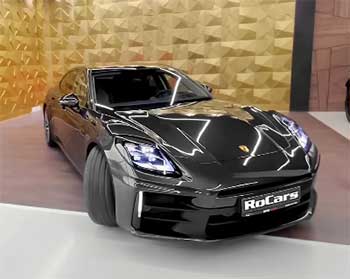
Walking up to the 2024 Porsche Panamera Turbo E-Hybrid, I’m struck by its commanding presence.
It’s a sleek, muscular sedan that stretches nearly 200 inches long, with sharp LED headlights and a refined front fascia that screams sophistication.
The Panamera’s redesign for 2024 borrows cues from the 911, like the full-width LED taillight bar, but it’s unmistakably a luxury sedan.
It’s the kind of car that turns heads at a valet stand, blending elegance with aggression.
Then there’s the Porsche 911 Carrera S, the poster child of sports cars. Its compact, curvaceous body and iconic round headlights exude timeless cool. It’s shorter, lower, and leaner, with a rear-engine layout that gives it a distinctive, purposeful stance.
Parking them side by side, the 911 feels like a precision scalpel, while the Panamera is a sledgehammer wrapped in silk. Both are gorgeous, but the 911’s compact allure feels more visceral, while the Panamera’s grandeur suits a CEO’s driveway.
Performance of Porsche Panamera And 911
Let’s talk about what gets my pulse racing: performance. The Panamera Turbo E-Hybrid is a beast, packing a 4.0-liter twin-turbo V8 paired with a 140-kW electric motor for a combined 670 horsepower and 685 lb-ft of torque.
It rockets from 0 to 60 mph in just 3.0 seconds, a figure that feels surreal for a car weighing over 5,200 pounds. The electric motor’s instant torque fills in any turbo lag, delivering seamless, neck-snapping acceleration.
On a twisty mountain road, the all-wheel-drive system and optional Porsche Active Ride suspension keep it planted, almost defying physics. The active suspension, with its electrohydraulic pumps, eliminates body roll, making the Panamera feel flatter than a Formula 1 car in corners.
The 911 Carrera S, with its 3.0-liter twin-turbo flat-six, produces 443 horsepower and 390 lb-ft of torque. It’s no slouch, hitting 60 mph in 3.5 seconds, but it lacks the Panamera’s brute force. What it offers instead is agility.
At 3,500 pounds, it’s nearly 1,700 pounds lighter, making it dance through corners with a nimbleness the Panamera can’t match. The rear-wheel-drive setup and adaptive PASM suspension give it a raw, connected feel—like an extension of your body.
The 911’s engine note, a snarling flat-six growl, is automotive poetry, while the Panamera’s V8 roar, though thrilling, feels more refined.
The Panamera’s hybrid system adds a unique dimension: about 30 miles of electric-only range. I tested it in E-Power mode, cruising silently through city streets, feeling like I was cheating the gas station.
The 911, being pure combustion, doesn’t offer this eco-friendly trick, but its lighter weight and precise handling make it the purist’s choice for a weekend canyon carve.
Pros And Cons: Panamera Turbo E-Hybrid
Pros
- Monstrous Power: 670 hp and 685 lb-ft make it a supercar in sedan clothing.
- Electric Range: ~30 miles of EV driving is perfect for short commutes or city runs.
- Luxury and Space: Four full-size seats and a 14.3 cu-ft trunk make it practical.
- Advanced Tech: Optional Active Ride suspension is a game-changer for comfort and handling.
- Versatility: Switches effortlessly between luxury cruiser and track monster.
Cons
- Pricey: Starts at $192,995, and options can push it past $250,000.
- Weight: At 5,200 lbs, it feels heavy in tight corners compared to lighter sports cars.
- Complexity: The hybrid system adds maintenance concerns over time.
- Fuel Economy: 23 mpg combined isn’t stellar for a hybrid when not in EV mode.
Pros And Cons: Porsche 911 Carrera S
Pros
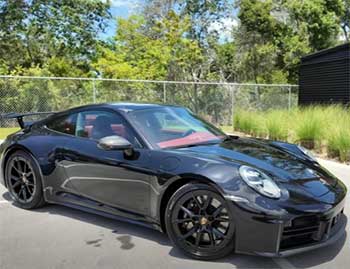
- Agility: Lightweight at 3,500 lbs, it’s a corner-carving dream.
- Iconic Design: Timeless looks that scream “Porsche” from every angle.
- Driving Purity: Rear-wheel drive and flat-six engine deliver a raw, engaging experience.
- Price: Starts at $131,300, significantly cheaper than the Panamera.
- Resale Value: 911s hold value better due to their iconic status.
Cons
- Limited Practicality: 2+2 seating and a tiny 4.6 cu-ft frunk limit utility.
- Less Power: 443 hp is thrilling but can’t match the Panamera’s brute force.
- No Hybrid Option: Lacks the eco-friendly versatility of the Panamera.
- Rear Seat Comfort: Cramped back seats are more for show than daily use.
Key Differences Between Porsche Panamera And 911
- Interior: Comfort Meets Craftsmanship
Stepping into the Panamera’s cabin feels like entering a luxury jet. The 2024 model boasts Porsche’s Driver Experience cockpit, with a 12.3-inch touchscreen, a 12.6-inch digital gauge cluster, and an optional 10.9-inch passenger screen.
The materials—soft leather, Alcantara, and carbon fiber—exude opulence. The 18-way adjustable sport seats hug you like a tailored suit, and the rear seats comfortably fit two adults, even on long drives. The 14.3 cu-ft trunk swallows luggage for a weekend getaway, making it a true grand tourer.
The 911’s interior, while equally premium, is more intimate. The low-slung driving position and snug cockpit make you feel like a racecar driver. The same high-quality leather and Alcantara are present, but the 2+2 layout means the rear seats are best for kids or briefcases.
The frunk’s 4.6 cu-ft capacity is enough for a couple of duffels, but don’t plan a Costco run. The 911’s infotainment is similar, with a crisp touchscreen and Apple CarPlay, but it lacks the Panamera’s optional passenger screen and overall spaciousness.
- Driving Dynamics: Track Star vs. Grand Tourer
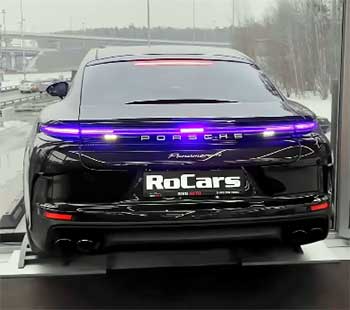
On a recent drive through the winding roads of Southern California, I pushed both cars to their limits.
The Panamera Turbo E-Hybrid, with its all-wheel drive and Active Ride suspension, felt unflappable.
It glided over bumpy pavement like a magic carpet, yet in Sport Plus mode, it transformed into a track weapon.
I took it to a local circuit, and the carbon-ceramic brakes and rear-axle steering made it surprisingly nimble for its size.
However, its 5,200-pound heft was noticeable in tight hairpins, where it leaned on grip rather than agility.
The 911, on the other hand, was pure joy. Its rear-engine layout and lighter weight made it feel like it was reading my mind through every corner. The steering is razor-sharp, and the chassis communicates every pebble on the road.
On the same track, it was a scalpel, slicing through apexes with precision. But on long highway stretches, the 911’s firmer ride and louder cabin reminded me it’s a sports car first, not a cruiser. The Panamera, in contrast, soaked up miles in serene comfort, especially in E-Power mode.
- Technology and Features
Both cars are tech marvels, but they cater to different needs. The Panamera’s optional Active Ride suspension is a standout, using hydraulic pumps to keep the car level in corners and smooth over bumps.
It’s like having a luxury sedan and a sports car in one. The hybrid system integrates seamlessly, with modes like E-Power, Hybrid, and Sport Plus letting you tailor the experience. Standard features include a Bose audio system, adaptive cruise control, and lane-keeping assist, with options like a head-up display and night vision.
The 911 keeps it simpler but no less impressive. Its adaptive PASM suspension adjusts damping on the fly, and the Sport Chrono package adds launch control and a drive mode selector. The 911’s tech focuses on performance—think torque vectoring and optional rear-axle steering—rather than luxury add-ons.
Both cars offer Porsche’s intuitive PCM infotainment, but the Panamera’s larger screens and optional passenger display give it a slight edge for tech lovers.
- Practicality: Daily Driver vs. Weekend Warrior
As someone who juggles work commutes, family trips, and weekend track days, practicality matters. The Panamera shines here. Its four doors, spacious rear seats, and 14.3 cu-ft trunk make it a legitimate daily driver.
I loaded it with groceries, a stroller, and gym bags without breaking a sweat. The hybrid system’s electric range is a bonus for short trips, and the 23 mpg combined (estimated) is decent for a 670-hp sedan. It’s the car you’d take on a cross-country road trip with friends.
The 911, by contrast, is a weekend warrior. Its 2+2 seating is cramped, and the frunk’s 4.6 cu-ft capacity limits you to a backpack or two. I tried using it for a week of errands, and the lack of space was a constant frustration.
Fuel economy is slightly worse at 20 mpg combined, and without a hybrid option, it’s less versatile for city driving. But when the road opens up, the 911’s pure driving joy makes you forget those limitations.
- Cost and Value
Price is where things get tricky. The Panamera Turbo E-Hybrid starts at $192,995, and with options like the Active Ride suspension ($7,000) and carbon-ceramic brakes ($9,000), it can easily hit $250,000.
It’s a lot, but you’re getting supercar performance, luxury sedan comfort, and hybrid efficiency. The 911 Carrera S, starting at $131,300, is a relative bargain. Even with options like the Sport Chrono package ($2,700) and premium leather ($4,000), it stays under $150,000.
The 911’s iconic status also means better resale value, while the Panamera’s higher price and hybrid complexity might hurt depreciation.
For me, the Panamera’s versatility justifies its cost if you need a do-it-all car. But if driving purity is your priority and you don’t need the extra space, the 911 offers incredible value for a sports car legend.
- Emotional Connection: Heart vs. Head
Driving the 911 is an emotional experience. Its compact size, howling flat-six, and telepathic handling make every drive feel special. It’s the car I’d pick for a sunrise blast through the mountains, where every turn feels like a dance.
The Panamera, while thrilling, appeals more to my practical side. It’s the car I’d choose for a long trip with my partner, where we could enjoy luxury, space, and still outrun most cars on the road. The 911 is my heart; the Panamera is my head.
Choosing The Right Porsche For You
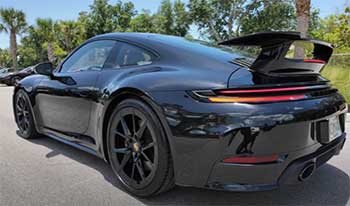
So, which Porsche is right for you?
If you live for driving and don’t need much practicality, the 911 Carrera S is your soulmate.
Its agility, iconic design, and lower price make it a purist’s dream.
But if you want a car that can do everything—commute, cruise, carry passengers, and still embarrass supercars—the Panamera Turbo E-Hybrid is unmatched.
It’s more expensive and heavier, but its versatility and tech are hard to beat.
For me, the choice depends on the day. On a quiet Sunday morning, I’d grab the 911’s keys without hesitation. But for a week-long road trip or a busy day of errands, the Panamera’s practicality wins. Your lifestyle will dictate which Porsche steals your heart—or your head.
Frequently Asked Questions (FAQ)
It depends on your needs. The 911 is better for pure driving thrills and iconic style, while the Panamera offers more power, space, and versatility.
The 911 Carrera S is better for performance-focused drivers who prioritize agility over practicality. The Panamera is better for those needing a luxurious, spacious sedan.
There’s no single “best” Porsche—it depends on your priorities. The 911 is a sports car icon, while the Panamera blends supercar speed with sedan utility.
The Panamera Turbo E-Hybrid competes with luxury performance sedans like the Mercedes-AMG GT 63 S E Performance, BMW M8 Gran Coupe, and Audi RS7.
Conclusion: Your Porsche, Your Choice
You’re now armed with the full picture of the 2024 Porsche Panamera Turbo E-Hybrid and the Porsche 911 Carrera S. The Panamera offers unmatched power, luxury, and practicality, making it the ultimate all-rounder for those who want it all.
The 911, with its raw driving dynamics and timeless appeal, is for those who live for the thrill of the drive. Whether you lean toward the Panamera’s versatility or the 911’s purity, you can’t go wrong.
Pick the one that speaks to your soul, and you’ll be grinning every time you hit the road.
